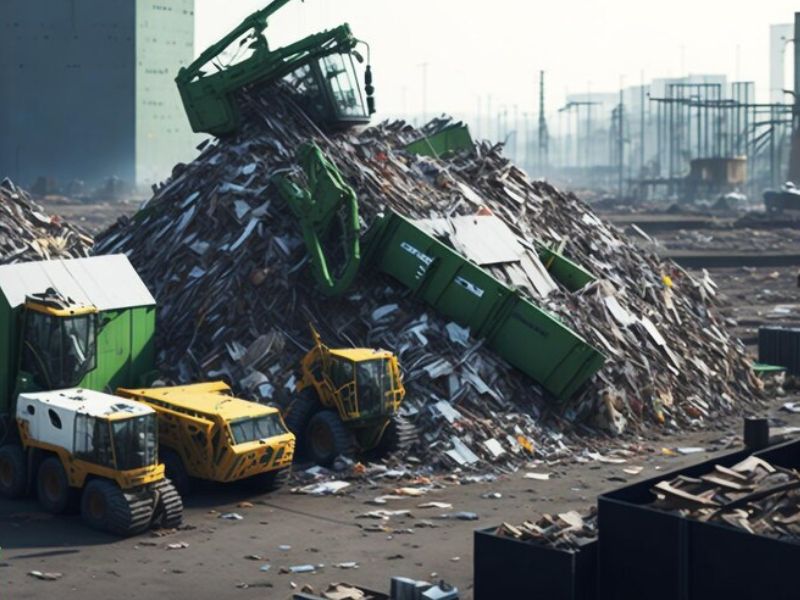Introduction
In the world of recycling, there’s a hidden gem waiting to be discovered amidst heaps of discarded metal. It’s the art of transforming scrap metal into valuable treasure, and we’re here to unveil the secrets behind these transformative retrieval methods.
With a keen focus on sustainability and resource conservation, our brand is leading the way in revolutionizing scrap metal recovery. Through cutting-edge technologies and innovative techniques, we’re turning junk into jewels that hold both aesthetic and monetary value.
In this article, we’ll delve into the different approaches and strategies employed by industry experts to extract the hidden potential of scrap metal. From advanced metal detection systems to specialized sorting methods, we’ll explore the various stages of the retrieval process and how they contribute to a more efficient and environmentally friendly recycling industry.
The Importance of Scrap Metal Retrieval
As the demand for sustainable practices continues to rise, the importance of scrap metal retrieval cannot be overstated. Scrap metal is a valuable resource that, if left unutilized, adds to the burden on natural resources and the environment. By implementing effective retrieval methods, we can reduce our dependence on virgin materials and minimize the carbon footprint associated with their extraction and processing.
In addition, Scrap Metal Pick up for Cash contributes to waste management in a variety of ways. By diverting metal waste from landfills, we can mitigate the adverse environmental impacts of improper disposal. Recycling scrap metal conserves resources and reduces energy consumption and greenhouse gas emissions, making it a win-win solution for both the economy and the environment.
Understanding the Different Types of Scrap Metal
Scrap metal comes in a wide range of forms, each with distinct properties that determine its value and potential uses. The most common types of scrap metal include ferrous and non-ferrous metals.
Ferrous metals, such as iron and steel, contain iron as their primary component. These metals are highly magnetic and are widely used in construction, automotive, and manufacturing industries. Non-ferrous metals, on the other hand, do not contain iron and exhibit different properties. Common non-ferrous metals include aluminum, copper, brass, and lead, which find applications in various industries, including electronics, plumbing, and transportation.
By identifying and properly classifying the different types of scrap metal, recyclers can optimize the retrieval process and ensure that each material is handled appropriately. This classification also helps determine the market value of the scrap metal, as certain metals command higher prices due to their scarcity or specific properties.
Common Sources of Scrap Metal
Scrap metal can be found in numerous sources, both industrial and domestic. Industrial sources include manufacturing plants, construction sites, and automotive workshops, where large quantities of metal waste are generated. These sources often yield a vast assortment of metal, ranging from structural steel beams to discarded machinery parts.
On the domestic front, household appliances, electronics, and old vehicles are significant contributors to the scrap metal pool. From refrigerators and washing machines to obsolete computers and smartphones, these items contain valuable metals that can be recycled and repurposed.
Additionally, infrastructure demolition projects and renovation activities generate significant amounts of scrap metal. By salvaging metal from these sources, we can not only reduce waste but also preserve historical and architectural elements that hold cultural value.
Traditional Scrap Metal Retrieval Methods
Traditionally, scrap metal retrieval involved manual labor and basic tools. Workers would manually sort through piles of metal, separating them based on their type and quality. While this method is still prevalent, it is time-consuming and labor-intensive, making it less efficient for large-scale operations.
Magnetic separation is another traditional method used to retrieve ferrous metals. By utilizing powerful magnets, ferrous metals can be easily separated from other materials, simplifying the sorting process. However, this method is limited to ferrous metals only and does not account for non-magnetic metals like aluminum or copper.
Innovative Technologies
To overcome the limitations of traditional methods, innovative technologies have emerged in the field of scrap metal retrieval. Advanced metal detection systems, such as X-ray scanners and electromagnetic sensors, have revolutionized the sorting process by accurately identifying different types of metal in real-time.
These technologies employ sophisticated algorithms and machine learning to analyze the composition and characteristics of metal objects, enabling precise identification and separation. By automating the sorting process, these systems not only increase efficiency but also improve the quality of the retrieved scrap metal.
Site: https://www.metalbiz.com.au/scrap-metal/gold-coast/
Benefits of Using Advanced Scrap Metal Retrieval Methods
The adoption of advanced scrap metal retrieval methods offers several benefits to both recyclers and the environment. Firstly, these methods significantly reduce the reliance on manual labor, allowing for faster and more efficient retrieval processes. This not only saves time but also reduces operational costs, making recycling a more economically viable option.
Secondly, advanced retrieval methods enable the extraction of valuable metals from complex objects, such as electronic devices, where traditional methods fall short. This ensures that a larger percentage of the metal content is recovered, maximizing the recycling potential and reducing the need for additional mining and processing.
Moreover, by improving the accuracy of metal sorting, advanced technologies help maintain a higher quality of recycled materials. This, in turn, increases the market value of the recycled metal, making it a more attractive option for manufacturers and consumers.
Environmental Impact
The environmental impact of scrap metal retrieval cannot be underestimated. By diverting metal waste from landfills and reducing the demand for virgin materials, we can conserve natural resources and minimize the energy-intensive processes associated with metal extraction and refining.
Additionally, recycling scrap metal significantly reduces greenhouse gas emissions. The production of metal from virgin materials is incredibly energy-intensive, emitting large amounts of carbon dioxide into the atmosphere. By recycling metal, we can reduce these emissions and mitigate the contribution of the metal industry to climate change.
Furthermore, the proper disposal of metal waste prevents the leaching of harmful substances into the environment. Many scrap metal items, such as batteries and electronic devices, contain toxic materials that, if not handled correctly, can contaminate soil and water sources. Recycling ensures that these hazardous materials are safely extracted and disposed of, minimizing the risk to human health and the ecosystem.
Safety Considerations
While scrap metal retrieval offers numerous benefits, it is essential to prioritize safety throughout the process. Metal objects can be sharp, heavy, or contain hazardous materials, posing risks to both workers and the environment.
Proper training and personal protective equipment (PPE) are crucial for workers involved in scrap metal retrieval. This includes wearing gloves, safety glasses, and steel-toed boots to protect against physical hazards. Additionally, workers should be educated about the potential dangers associated with certain metal types, such as lead or asbestos, and how to handle them safely.
Furthermore, it is important to implement proper waste management practices to prevent pollution and accidents. This includes segregating different types of metal waste, storing them securely, and disposing of hazardous materials in accordance with local regulations.
Tips for Successful Scrap Metal Retrieval
Successfully retrieving scrap metal requires a combination of knowledge, strategy, and efficiency. Here are a few tips to enhance the effectiveness of your scrap metal retrieval efforts:
-
Research and familiarize yourself with the different types of scrap metal and their market values. This will help you prioritize the retrieval of high-value metals and optimize your earnings.
-
Invest in advanced metal detection systems and sorting equipment to streamline the retrieval process and improve efficiency.
-
Network with local businesses, construction sites, and individuals who may have scrap metal they wish to dispose of. Building relationships and establishing partnerships can provide a consistent supply of metal waste.
-
Stay updated on industry trends and technological advancements to ensure you are utilizing the most efficient and effective retrieval methods available.
-
Implement proper storage and handling practices to prevent accidents and ensure the safety of workers and the environment.
Site: https://www.metalbiz.com.au/scrap-metal/ipswich/
Conclusion:
As the world becomes increasingly conscious of the need for sustainable practices, scrap metal retrieval is gaining prominence as a crucial component of the recycling industry. By leveraging advanced technologies and innovative methods, we can unlock the hidden potential of scrap metal and transform it into valuable resources.
From magnetic separation and manual sorting to robotic systems and advanced metal detection, the evolution of scrap metal retrieval methods has revolutionized the industry. These methods not only improve efficiency and profitability but also contribute to a more sustainable, resource-efficient future.





